Allies of World War I
The Triple Entente | |
|---|---|
| 1907–1918 | |
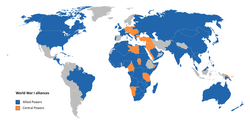 Entente in blue;Central Powersin orange
Principal Entente Powers:
Associated allies and co-belligerents:
| |
| Status | Military alliance |
| Historical era | World War I |
• Established | 1907 |
• Disestablished | 1918 |
TheAllies,theEntenteor theTriple Ententewas an international militarycoalitionof countries led byFrance,theUnited Kingdom,Russia,theUnited States,Italy,andJapanagainst theCentral PowersofGermany,Austria-Hungary,theOttoman Empire,andBulgariainWorld War I(1914–1918).
By the end of the first decade of the 20th century, the major European powers were divided between theTriple Ententeand theTriple Alliance.The Triple Entente was made up of the United Kingdom, France, and Russia. The Triple Alliance was originally composed of Germany, Austria–Hungary, and Italy, but Italy remained neutral in 1914. As the war progressed, each coalition added new members. Japan joined the Entente in 1914 and, despite proclaiming its neutrality at the beginning of the war, Italy also joined the Entente in 1915. The term "Allies" became more widely used than "Entente"[citation needed],although the United Kingdom, France, Russia, and Italy were also referred to as theQuadruple Ententeand, together with Japan, as theQuintuple Entente.[1][2]The colonies administered by the countries that fought for the Allies were also part of the Entente powers such asAmerican Philippines,Belgian Congo,British India,French Algeria,andJapanese Korea.
The United States joined near the end of the war in 1917 (the same year in which Russia withdrew from the conflict) as an "associated power" rather than an official ally. Other "associated members" includedSerbia,Belgium,Montenegro,Asir,Nejd and Hasa,Portugal,Romania,Hejaz,Panama,Cuba,Greece,China,Siam,Brazil,Armenia,Luxembourg,Guatemala,Nicaragua,Costa Rica,Haiti,Liberia,andHonduras.[3]The treaties signed at theParis Peace Conferencerecognized the United Kingdom, France, Italy, Japan, and the United States as "the Principal Allied and Associated Powers".[4]
Background
[edit]When the war began in 1914, theCentral Powerswere opposed by theTriple Entente,formed in 1907 when the agreement between the United Kingdom andRussiacomplemented existing agreements between the three powers.
Fighting commenced when Austria invadedSerbiaon 28 July 1914, purportedly in response to theassassination of Archduke Franz Ferdinand,heir to EmperorFranz Joseph I;this brought Serbia's allyMontenegrointo the war on 8 August and it attacked the Austrian naval base atCattaro,modern Kotor.[5]At the same time, German troops carried out theSchlieffen Plan,entering neutralBelgiumandLuxembourg;over 95% of Belgium was occupied but the Belgian Army held their lines on theYser Frontthroughout the war. This allowed Belgium to be treated as an Ally, in contrast to Luxembourg which retained control over domestic affairs but wasoccupied by the German military.
In the East, between 7 and 9 August the Russians entered GermanEast Prussiaon 7 August, AustrianEastern Galicia.Japanjoined the Entente by declaring war on Germany on 23 August, then Austria on 25 August.[6]On 2 September, Japanese forces surrounded the GermanTreaty PortofTsingtao(now Qingdao) in China and occupied German colonies in the Pacific, including theMariana,Caroline,andMarshall Islands.
Despite its membership of theTriple Alliance,Italyremained neutral until 23 May 1915 when it joined the Entente, declaring war on Austria but not Germany. On 17 January 1916,Montenegrocapitulated and left the Entente;[7]this was offset when Germany declared war onPortugalin March 1916, whileRomaniacommenced hostilities against Austria on 27 August.[8]
On 6 April 1917, the United States entered the war as a co-belligerent, along with the associated allies ofLiberia,SiamandGreece.After the 1917October Revolution,Russia left the Entente and agreed to a separate peace with the Central Powers with the signing of theTreaty of Brest-Litovskon 3 March 1918. Romania was forced to do the same in the May 1918Treaty of Bucharestbut on 10 November, it repudiated the Treaty and once more declared war on the Central Powers.
These changes meant the Allies who negotiated theTreaty of Versaillesin 1919 included the United Kingdom, France, Italy, Japan and the United States; Part One of the Treaty agreed to the establishment of theLeague of Nationson 25 January 1919.[9]This came into being on 16 January 1920 with Britain, France, Italy and Japan as permanent members of the Executive Council; theUS Senatevoted against ratification of the treaty on 19 March, thus preventing the United States from joining the League.
Statistics
[edit]For similar statistics of the Central Powers, seeCentral_Powers#Statistics.
| Country | Population(millions) | Land(million km2) | GDP($ billion, 1990 prices) | Mobilized personnel | |
|---|---|---|---|---|---|
| First Wave (1914) | |||||
| Russian Empire | Russia (inc.Poland) | 173.2 | 21.7 | 257.7 | 12,000,000[11] |
| Finland | 3.2 | 0.4 | 6.6 | ||
| Total | 176.4 | 22.1 | 264.3 | ||
| French Republic | France | 39.8 | 0.5 | 138.7 | 8,410,000[11] |
| French colonies | 48.3 | 10.7 | 31.5 | ||
| Total | 88.1 | 11.2 | 170.2 | ||
| British Empire | United Kingdom | 46.0 | 0.3 | 226.4 | 6,211,922[12] |
| British colonies | 380.2 | 13.5 | 257 | 1,440,437[13][14] | |
| BritishDominions | 19.9 | 19.5 | 77.8 | 1,307,000[13] | |
| Total | 446.1 | 33.3 | 561.2 | 8,689,000[15] | |
| Empire of Japan | Japan | 55.1 | 0.4 | 76.5 | 800,000[11] |
| Japanese colonies[16] | 19.1 | 0.3 | 16.3 | ||
| Total | 74.2 | 0.7 | 92.8 | ||
| Serbia,Montenegro,andBosnia and Herzegovina | 7.0 | 0.2 | 7.2 | 760,000[11] | |
| Second Wave (1915–1916) | |||||
| Kingdom of Italy | Italy | 35.6 | 0.3 | 91.3 | 5,615,000[11] |
| Italian colonies | 2.0 | 2.0 | 1.3 | ||
| Total | 37.6 | 2.3 | 92.6 | ||
| Portuguese Republic | Portugal | 6.0 | 0.1 | 7.4 | 100,000[11] |
| Portuguese colonies | 8.7 | 2.4 | 5.2 | ||
| Total | 14.7 | 2.5 | 12.6 | ||
| Kingdom of Romania | 7.7 | 0.1 | 11.7 | 750,000[11] | |
| Third Wave (1917–1918) | |||||
| Latin America | Latin America | ||||
| United Statesof America | United States | 96.5 | 7.8 | 511.6 | 4,355,000[11] |
| overseas dependencies[17] | 9.8 | 1.8 | 10.6 | ||
| Total | 106.3 | 9.6 | 522.2 | ||
| Central Americanstates[18] | 9.0 | 0.6 | 10.6 | ||
| Republic of the United States of Brazil | 25.0 | 8.5 | 20.3 | 1,713[19] | |
| Kingdom of Greece | 4.8 | 0.1 | 7.7 | 230,000[11] | |
| Kingdom of Siam | 8.4 | 0.5 | 7.0 | 1,284[12] | |
| Republic of China | 441.0 | 11.1 | 243.7 | ||
| Republic of Liberia | 1.5 | 0.1 | 0.9 | ||
| Group | Population(millions) | Territory(million km2) | GDP($ billion) | ||
|---|---|---|---|---|---|
| November 1914 | |||||
| Allies, total | 793.3 | 67.5 | 1,096.5 | ||
| UK, France and Russia only | 259.0 | 22.6 | 622.8 | ||
| November 1916 | |||||
| Allies, total | 853.3 | 72.5 | 1,213.4 | ||
| UK, France and Russia only | 259.0 | 22.6 | 622.8 | ||
| November 1918 | |||||
| Allies, total | 1,271.7 | 80.8 | 1,760.5 | ||
| Percentage of world | 70% | 61% | 64% | ||
| UK, France and US only | 182.3 | 8.7 | 876.6 | ||
| Percentage of world | 10% | 7% | 32% | ||
| Central Powers[21] | 156.1 | 6.0 | 383.9 | ||
| World, 1913 | 1,810.3 | 133.5 | 2,733.9 | ||
Principal powers
[edit]Britain and its Empire
[edit]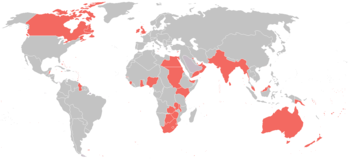
For much of the 19th century, Britain sought to maintain the European balance of power without formal alliances, a policy known assplendid isolation.This left it dangerously exposed as Europe divided into opposing power blocs and the1895–1905 Conservative governmentnegotiated first the 1902Anglo-Japanese Alliance,then the 1904Entente Cordialewith France.[22]The first tangible result of this shift was British support for France against Germany in the1905 Moroccan Crisis.
The1905–1915 Liberal governmentcontinued this re-alignment with the 1907Anglo-Russian Convention.Like the Anglo-Japanese and Entente agreements, it focused on settling colonial disputes but by doing so paved the way for wider co-operation and allowed Britain to refocus resources in response toGerman naval expansion.[23]

Since control of Belgium allowed an opponent to threaten invasion or blockade British trade, preventing it was a long-standing British strategic interest.[d][24]Under Article VII of the 1839Treaty of London,Britain guaranteed Belgian neutrality against aggression by any other state, by force if required.[25]ChancellorTheobald von Bethmann Hollweglater dismissed this as a 'scrap of paper,' but British law officers routinely confirmed it as a binding legal obligation and its importance was well understood by Germany.[26]
The 1911Agadir Crisisled to secret discussions between France and Britain in case of war with Germany. These agreed that within two weeks of its outbreak, aBritish Expeditionary Forceof 100,000 men would be landed in France; in addition, theRoyal Navywould be responsible for theNorth Sea,theChanneland protecting Northern France, with the French navy concentrated in theMediterranean.[27]Britain was committed to support France in a war against Germany but this was not widely understood outside government or the upper ranks of the military.
As late as 1 August, a clear majority of the Liberal government and its supporters wanted to stay out of the war.[28]While Liberal leadersH. H. AsquithandEdward Greyconsidered Britain legally and morally committed to support France regardless, waiting until Germany triggered the 1839 Treaty provided the best chance of preserving Liberal party unity.[29]

The German high command was aware entering Belgium would lead to British intervention but decided the risk was acceptable; they expected a short war while their ambassador in London claimed troubles in Ireland would prevent Britain from assisting France.[30]On 3 August, Germany demanded unimpeded progress through any part of Belgium and when this was refused, invaded early on the morning of 4 August.
This changed the situation; the invasion of Belgium consolidated political and public support for the war by presenting what appeared to be a simple moral and strategic choice.[31]The Belgians asked for assistance under the 1839 Treaty and in response, Britain declared war on Germany on 4 August 1914.[32]Although Germany's violation of Belgium neutrality was not the only cause of British entry into the war, it was used extensively in government propaganda at home and abroad to make the case for British intervention.[33]This confusion arguably persists today.
The declaration of war automatically involved all dominions and colonies and protectorates of theBritish Empire,many of whom made significant contributions to the Allied war effort, both in the provision of troops and civilian labourers. It was split intoCrown Coloniesadministered by theColonial Officein London, such asNigeria,[e]and the self-governingDominionsofCanada,Newfoundland,New Zealand,AustraliaandSouth Africa.These controlled their own domestic policies and military expenditure but not foreign policy.

In terms of population, the largest component (after Britain herself) was theBritish Rajor British India, which included modernIndia,Pakistan,MyanmarandBangladesh.Unlike other colonies which came under theColonial Office,it was governed directly by theIndia Officeor byprinces loyalto the British; it also controlled British interests in thePersian Gulf,such as theTrucial StatesandOman.Over one million soldiers of theBritish Indian Armyserved in different theatres of the war, primarily France and theMiddle East.
From 1914 to 1916, overall Imperial diplomatic, political and military strategy was controlled by theBritish War Cabinetin London; in 1917 it was superseded by theImperial War Cabinet,which included representatives from the Dominions.[34]Under the War Cabinet were theChief of the Imperial General Staff or CIGS,responsible for all Imperial ground forces, and theAdmiraltythat did the same for theRoyal Navy.Theatre commanders likeDouglas Haigon theWestern FrontorEdmund AllenbyinPalestinethen reported to the CIGS.
After the Indian Army, the largest individual units were theAustralian CorpsandCanadian Corpsin France, which by 1918 were commanded by their own generals,John MonashandArthur Currie.[35]Contingents from South Africa, New Zealand and Newfoundland served in theatres including France,Gallipoli,German East Africaand the Middle East. Australian troops separately occupiedGerman New Guinea,with the South Africans doing the same inGerman South West Africa;this resulted in theMaritz rebellionby former Boers, which was quickly suppressed. After the war, New Guinea and South-West Africa becameProtectorates,held until 1975 and 1990 respectively.
Russian Empire
[edit]
Between 1873 and 1887, Russia was allied with Germany and Austria-Hungary in theLeague of the Three Emperors,then with Germany in the 1887–1890Reinsurance Treaty;both collapsed due to the competing interests of Austria and Russia in theBalkans.While France took advantage of this to agree the 1894Franco-Russian Alliance,Britain viewed Russia with deep suspicion; in 1800, over 3,000 kilometres separated the Russian Empire and British India, by 1902, it was 30 km in some areas.[36]This threatened to bring the two into direct conflict, as did the long-held Russian objective of gaining control of theBosporus Straitsand with it access to the British-dominatedMediterranean Sea.[37]

Defeat in the 1905 Russo-Japanese War and Britain's isolation during the 1899–1902Second Boer Warled both parties to seek allies. TheAnglo-Russian Conventionof 1907 settled disputes in Asia and allowed the establishment of the Triple Entente with France, which at this stage was largely informal. In 1908, Austria annexed the former Ottoman province ofBosnia and Herzegovina;Russia responded by creating theBalkan Leaguein order to prevent further Austrian expansion.[38]In the 1912–1913First Balkan War,Serbia,BulgariaandGreececaptured most of the remaining Ottoman possessions in Europe; disputes over the division of these resulted in theSecond Balkan War,in which Bulgaria was comprehensively defeated by its former allies.
Russia's industrial base and railway network had significantly improved since 1905, although from a relatively low base; in 1913,Tsar Nicholasapproved an increase in the Russian Army of over 500,000 men. Although there was no formal alliance between Russia and Serbia, their close bilateral links provided Russia with a route into the crumbling Ottoman Empire, where Germany also had significant interests. Combined with the increase in Russian military strength, both Austria and Germany felt threatened by Serbian expansion; when Austria invaded Serbia on 28 July 1914, Russian Foreign MinisterSergey Sazonovviewed it as an Austro-German conspiracy to end Russian influence in the Balkans.[39]
In addition to its own territory, Russia viewed itself as the defender of its fellowSlavsand on 30 July, mobilized in support of Serbia. In response, Germany declared war on Russia on 1 August, followed by Austria-Hungary on 6th; after Ottoman warships bombardedOdesain late October, the Entente declared war on the Ottoman Empire in November 1914.[40]
French Republic
[edit]
French defeat in the 1870–1871Franco-Prussian Warled to the loss of the two provinces ofAlsace-Lorraineand the establishment of theThird Republic.The suppression of theParis Communeby the new regime caused deep political divisions and led to a series of bitter political struggles, such as theDreyfus affair.As a result, aggressive nationalism orRevanchismwas one of the few areas to unite the French.
The loss of Alsace-Lorraine deprived France of its natural defence line on theRhine,while it was weaker demographically than Germany, whose 1911 population was 64.9 million to 39.6 in France, which had the lowest birthrate in Europe.[41]This meant that despite their very different political systems, when Germany allowed the Reinsurance Treaty to lapse, France seized the opportunity to agree the 1894Franco-Russian Alliance.It also replaced Germany as the primary source of financing for Russian industry and the expansion of its railway network, particularly in border areas with Germany and Austria-Hungary.[42]
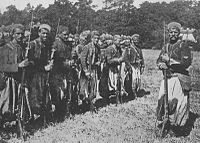
However, Russian defeat in the 1904–1905Russo-Japanese Wardamaged its credibility, while Britain's isolation during theSecond Boer Warmeant both countries sought additional allies. This resulted in the 1904Entente Cordialewith Britain; like the 1907Anglo-Russian Convention,for domestic British consumption it focused on settling colonial disputes but led to informal co-operation in other areas. By 1914, both the British army andRoyal Navywere committed to support France in the event of war with Germany but even in the British government, very few were aware of the extent of these commitments.[43]

In response to Germany's declaration of war on Russia, France issued a general mobilisation in expectation of war on 2 August and on 3 August, Germany also declared war on France.[44]Germany's ultimatum to Belgium brought Britain into the war on 4 August, although France did not declare war on Austria-Hungary until 12 August.
As with Britain, France'scoloniesalso became part of the war; pre-1914, French soldiers and politicians advocated using French African recruits to help compensate for France's demographic weakness. But it eventually proved useless, the soldiers fromMetropolitan Francestill undertook all the tasks.[45]From August to December 1914, the French lost nearly 300,000 dead on the Western Front, more than Britain suffered in the whole of WWII and the gaps were partly filled by colonial troops, over 500,000 of whom served on the Western Front over the period 1914–1918.[46]Colonial troops also fought atGallipoli,occupiedTogoandKamerunin West Africa and had a minor role in the Middle East, where France was the traditional protector of Christians in the Ottoman provinces ofSyria,PalestineandLebanon.[47]
Japanese Empire
[edit]Prior to theMeiji Restorationin 1868, Japan was a semi-feudal, largely agrarian state with few natural resources and limited technology. By 1914, it had transformed itself into a modern industrial state, with a powerful military; by defeating China in theFirst Sino-Japanese Warduring 1894–1895, it established itself as the primary power in East Asia and colonised the then-unified Korea andFormosa, now modern Taiwan.
Concerned by Russian expansion in Korea andManchuria,Britain and Japan signed theAnglo-Japanese Allianceon 30 January 1902, agreeing if either were attacked by a third party, the other would remain neutral and if attacked by two or more opponents, the other would come to its aid. This meant Japan could rely on British support in a war with Russia, if either France or Germany, which also had interests in China, decided to join them.[48]This gave Japan the reassurance needed to take on Russia in the 1905Russo-Japanese War;victory established Japan in the Chinese province ofManchuria.

With Japan as an ally in the Far East,John Fisher,First Sea Lordfrom 1904 to 1910, was able to refocus British naval resources in theNorth Seato counter the threat from theImperial German Navy.The Alliance was renewed in 1911; in 1914, Japan joined the Entente in return for German territories in the Pacific, greatly annoying the Australian government which also wanted them.[49]
On 7 August, Britain officially asked for assistance in destroying German naval units in China and Japan formally declared war on Germany on 23 August, followed by Austria-Hungary on 25th.[50]On 2 September 1914, Japanese forces surrounded the GermanTreaty PortofQingdao,then known as Tsingtao, which surrendered on 7 November. TheImperial Japanese Navysimultaneously occupied German colonies in theMariana,Caroline,andMarshall Islands,while in 1917, a Japanese naval squadron was sent to support the Allies in theMediterranean.[51]
Japan's primary interest was in China and in January 1915, the Chinese government was presented with a secret ultimatum ofTwenty-One Demands,demanding extensive economic and political concessions. While these were eventually modified, the result was a surge of anti-Japanesenationalismin China and an economic boycott of Japanese goods.[52]In addition, the other Allies now saw Japan as a threat, rather than a partner, lead to tensions first with Russia, then the US after it entered the war in April 1917. Despite protests from the other Allies, after the war Japan refused to return Qingdao and the province ofShandongto China.[53]
Kingdom of Italy
[edit]
The 1882Triple Alliancebetween Germany, Austria-Hungary and Italy was renewed at regular intervals, but was compromised by conflicting objectives between Italy and Austria in theAdriaticandAegeanseas. Italian nationalists referred to Austrian-heldIstria(includingTriesteandFiume) andTrentoas'the lost territories',making the Alliance so controversial that the terms were kept secret until it expired in 1915.[54]
Alberto Pollio,the pro-AustrianChief of Staff of the Italian Army,died on 1 July 1914, taking many of the prospects for Italian support with him.[55]The Italian Prime MinisterAntonio Salandraargued that as the Alliance was defensive in nature, Austria's aggression against Serbia and Italy's exclusion from the decision-making process meant it was not obliged to join them.[56]
His caution was understandable because France and Britain either supplied or controlled the import of most of Italy's raw materials, including 90% of its coal.[56]Salandra described the process of choosing a side as 'sacred egoism,' but as the war was expected to end before mid-1915 at the latest, making this decision became increasingly urgent.[57]In line with Italy's obligations under the Triple Alliance, the bulk of the army was concentrated on Italy's border with France; in October, Pollio's replacement,General Luigi Cadorna,was ordered to begin moving these troops to the North-Eastern one with Austria.[58]
Under the April 1915Treaty of London,Italy agreed to join the Entente in return for Italian-populated territories of Austria-Hungary and other concessions; in return, it declared war on Austria-Hungary in May 1915 as required, although not on Germany until 1916.[59]Italian resentment at the difference between the promises of 1915 and the actual results of the 1919Treaty of Versailleswould be powerful factors in the rise ofBenito Mussolini.[60]
Affiliated state combatants
[edit]Kingdom of Serbia
[edit]In 1817, thePrincipality of Serbiabecame an autonomous province within theOttoman Empire;with Russian support, it gained full independence after the 1877–1878Russo-Turkish War.Many Serbs viewed Russia as protector of theSouth Slavsin general but also specifically against Bulgaria, where Russian objectives increasingly collided withBulgarian nationalism.[61]
When Austria annexed Bosnia and Herzegovina in 1908, Russia responded by creating theBalkan Leagueto prevent further Austrian expansion.[38]Austria viewed Serbia with hostility partly due to its links with Russia, whose claim to be the protector of South Slavs extended to those within the Austro-Hungarian Empire, such as theCzechsandSlovaks.Serbia also potentially gave Russia the ability to achieve their long-held objective of capturingConstantinopleand theDardanelles.[37]

Austria-Hungary supported the idea of anindependent Albania,since this would prevent Serbian access to the Austrian-controlledAdriatic Sea.[62]The success of theAlbanian revolt in 1912threatened Serbian ambitions for the incorporation of "Old Serbia"into its domain and exposed the weakness of the Ottoman Empire. This led to the outbreak of theFirst Balkan War,withSerbia,Montenegro,BulgariaandGreececapturing most of the remaining Ottoman possessions in Europe. Disputes over the division of these resulted in theSecond Balkan War,in which Bulgaria was comprehensively defeated by its former allies.
As a result of the 1913Treaty of Bucharest,Serbia increased its territory by 100% and its population by 64%.[63]However, it now faced a hostile Austria-Hungary, a resentful Bulgaria andresistance in its conquered territories.Germany too had ambitions in the Ottoman Empire, the centrepiece being the plannedBerlin–Baghdad railway,with Serbia the only section not controlled by a pro-German state.
The exact role played by Serbian officials in theassassination of Archduke Franz Ferdinandis still debated but despite complying with most of their demands, Austria-Hungary invaded on 28 July 1914. While Serbia successfully repulsed the Austro-Hungarian army in 1914, it was exhausted by the two Balkan Wars and unable to replace its losses of men and equipment. In 1915, Bulgaria joined the Central Powers and by the end of the year, a combined Bulgar-Austrian-German army occupied most of Serbia. Between 1914 and 1918, Serbia suffered the greatest proportional losses of any combatant, with over 25% of all those mobilised becoming casualties; including civilians and deaths from disease, over 1.2 million died, nearly 30% of the entire population.
Kingdom of Belgium
[edit]In 1830, the southern provinces of the Netherlands broke away to form theKingdom of Belgiumand their independence was confirmed by the 1839Treaty of London.Article VII of the Treaty required Belgium to remain perpetually neutral and committed Austria, France, Germany and Russia to guarantee that against aggression by any other state, including the signatories.[64]


While the French and German militaries accepted Germany would almost certainly violate Belgian neutrality in the event of war, the extent of that was unclear. The originalSchlieffen Planonly required a limited incursion into the BelgianArdennes,rather than a full-scale invasion; in September 1911, the Belgian Foreign Minister told a British Embassy official they would not call for assistance if the Germans limited themselves to that.[43]While neither Britain or France could allow Germany to occupy Belgium unopposed, a Belgian refusal to ask for help would complicate matters for theBritish Liberal government,which contained a significant isolationist element.
However, the key German objective was to avoid war on two fronts; France had to be defeated before Russia could fully mobilise and give time for German forces to be transferred to the East. The growth of the Russian railway network and increase in speed of mobilisation made rapid victory over France even more important; to accommodate the additional 170,000 troops approved by the 1913 Army Bill, the 'incursion' now became a full-scale invasion. The Germans accepted the risk of British intervention; in common with most of Europe, they expected it to be a short war while their London Ambassador claimed civil war in Ireland would prevent Britain from assisting its Entente partners.[30]
On 3 August, a German ultimatum demanded unimpeded progress through any part of Belgium, which was refused. Early on the morning of 4 August, the Germans invaded and the Belgian government called for British assistance under the 1839 Treaty; by the end of 1914, over 95% of the country was occupied but the Belgian Army held their lines on theYser Frontthroughout the war.
In theBelgian Congo,25,000 Congolese troops plus an estimated 260,000 porters joined British forces in the 1916East African Campaign.[65]By 1917, they controlled the western part ofGerman East Africawhich would become the BelgianLeague of Nations MandateofRuanda-Urundior modern-dayRwandaandBurundi.[66]
Kingdom of Greece
[edit]

Greece almost doubled in size as a result of theBalkan Warsof 1912 and 1913, but the success masked deep divisions within the political elite. In 1908, the island ofCrete,formally part of theOttoman Empirebut administered by Greek officials, declared union with Greece, led by the charismatic nationalistEleftherios Venizelos.A year later, young army officers formed the Military League to advocate for an aggressive and expansionist foreign policy; with their backing, Venizelos won a majority in the 1910 Parliamentary elections, followed by another in 1912.[67]He had effectively broken the power of the pre-1910 political class and his position was then further strengthened by success in the Balkan Wars.
In 1913, the Greek monarchGeorge Iwas assassinated; he was succeeded by his sonConstantinewho had attendedHeidelberg University,served in a Prussian regiment and marriedSophia of Prussia,sister of EmperorWilliam II.These links and a belief the Central Powers would win the war combined to make Constantine pro-German.[68]Venizelos himself favoured the Entente, partly due to their ability to block the maritime trade routes required for Greek imports.

Other issues adding complexity to this decision included disputes with Bulgaria and Serbia over the regions ofThraceandMacedoniaas well as control of theAegean Islands.Greece captured most of the islands during the Balkan Wars but Italy occupied theDodecanesein 1912 and was in no hurry to give them back, while the Ottomans demanded the return of many others.[69]In general, the Triple Entente favoured Greece, the Triple Alliance backed the Ottomans; Greece ultimately gained the vast majority but Italy did not cede the Dodecanese until 1947, while others remaindisputedeven today.
As a result, Greece initially remained neutral but in March 1915, the Entente offered concessions to join theDardanellescampaign. Arguments over whether to accept led to theNational Schism,with an Entente-backed administration under Venizelos in Crete, and a Royalist one led by Constantine inAthensthat supported the Central Powers.[68]
In September 1915, Bulgaria joined the Central Powers; in October, Venizelos allowed Entente forces to land atThessaloniki or Salonicato support the Serbs, although they were too late to prevent their defeat. In August 1916, Bulgarian troops advanced into Greek-held Macedonia and Constantine ordered the army not to resist; anger at this led to a coup and he was eventually forced into exile in June 1917. A new national government under Venizelos joined the Entente, while the GreekNational Defence Army Corpsfought with the Allies on theMacedonian front.
Kingdom of Montenegro
[edit]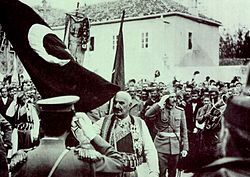
Unlike Serbia, with whom it shared close cultural and political connections, theKingdom of Montenegrogained little from its participation in the 1912–1913 Balkan Wars. The main Montenegrin offensive was inOttoman-controlled Albania,where it suffered heavy losses during the seven monthSiege of Scutari.Austria-Hungary opposed Serb or Montenegrin control of Albania, since it provided access to theAdriatic Sea;despite Scutari's surrender, Montenegro was forced to relinquish it by the1913 Treaty of Londonand it became capital of the short-livedPrincipality of Albania.[70]This was largely an Austrian creation; the new ruler,William, Prince of Albania,was a German who was forced into exile in September, only seven months after taking up his new position and later served with theImperial German Army.[71]
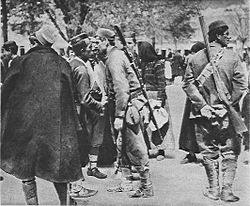
In addition to the lack of substantive gains from the Balkan Wars, there were long-running internal divisions between those who likeNicholas Ipreferred an independent Montenegro and those who advocated union with Serbia. In July 1914, Montenegro was not only militarily and economically exhausted, but also faced a multitude of political, economic and social issues.[72]
At meetings held in March 1914, Austria-Hungary and Germany agreed union with Serbia must be prevented; Montenegro could either remain independent or be divided, its coastal areas becoming part of Albania, while the rest could join Serbia.[72]
Nicholas seriously considered neutrality as a way to preserve his dynasty and on 31 July notified the Russian Ambassador Montenegro would only respond to an Austrian attack. He also held discussions with Austria, proposing neutrality or even active support in return for territorial concessions in Albania.[73]
However, close links between the Serbian and Montenegrin militaries as well as popular sentiment meant there was little support for remaining neutral, especially after Russia joined the war; on 1 August, the National Assembly declared war on Austria-Hungary in fulfilment of its obligations to Serbia. After some initial success, in January 1916, the Montenegrin Army was forced to surrender to an Austro-Hungarian force.
Beda Sultanate
[edit]TheBeda Sultanatewas invaded by Ottoman forces in February 1915 and March 1916.[74]Britain assisted the Beda Sultanate in defeating the Ottoman invasions by sending arms and ammunition.[75]
Idrisid Emirate of Asir
[edit]TheIdrisid Emirate of Asirparticipated in theArab Revolt.Its Emir,Muhammad ibn Ali al-Idrisi,signed an agreement with the British and joined the Allies in May 1915.
Emirate of Nejd and Hasa
[edit]TheEmirate of Nejd and Hasalaunched a failed offensive against the Ottoman aligned Emirate of Jabal Shammar in January 1915.It then agreed to enter the war as an ally of Britain in theTreaty of Darinon 26 December 1915.[76]
Kingdom of Romania
[edit]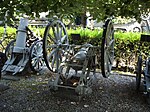


Equal status with the main Entente Powers was one of the primary conditions for Romania's entry into the War. The Powers officially recognised this status through the1916 Treaty of Bucharest.[77]Romania fought on three of the four European Fronts:Eastern,BalkanandItalian,fielding in total over 1,200,000 troops.[78]
Romanian military industry was mainly focused on converting various fortification guns into field and anti-aircraft artillery. Up to 334 German 53 mmFahrpanzerguns, 93 French 57 mm Hotchkiss guns, 66 Krupp 150 mm guns, and dozens more 210 mm guns were mounted on Romanian-builtcarriagesand transformed into mobile field artillery, with 45 Krupp 75 mm guns and 132 Hotchkiss 57 mm guns being transformed into anti-aircraft artillery. The Romanians alsoupgraded 120 German Krupp 105 mm howitzers,the result being the most effective field howitzer in Europe at that time. Romania even managed to design and build from scratch its own model of mortar, the 250 mm Negrei Model 1916.[79]
Other Romanian technological assets include the building ofVlaicu III,the world's first aircraft made of metal.[80]The Romanian Navy possessed the largest warships on the Danube. They were a class of four river monitors, built locally at theGalați shipyardusing parts manufactured in Austria-Hungary. The first one launched wasLascăr Catargiu,in 1907.[81][82]The Romanian monitors displaced almost 700 tons, were armed with three 120 mm naval guns in three turrets, two 120 mm naval howitzers, four 47 mm anti-aircraft guns and two 6.5 machine guns.[83]The monitors took part in theBattle of Turtucaiaand theFirst Battle of Cobadin.The Romanian-designed Schneider 150 mm Model 1912 howitzer was considered one of the most modern field guns on the Western Front.[84]
Romania's entry into the War in August 1916 provoked major changes for the Germans. GeneralErich von Falkenhaynwas dismissed and sent to command the Central Powers forces in Romania, which enabledHindenburg's subsequent ascension to power.[8]Due to having to fight against all of the Central Powers on the longest front in Europe (1,600 km) and with little foreign help (only 50,000 Russians aided 650,000 Romanians in 1916),[85]the Romanian capital was conqueredthat December. Vlaicu III was also captured and shipped to Germany, being last seen in 1942.[86]The Romanian administration established a new capital atIașiand continued to fight on the Allied side in 1917.[87]Despite being relatively short, the Romanian campaign of 1916 provided considerable respite for the Western Allies, as the Germans ceased all their other offensive operations in order to deal with Romania.[88]After suffering a tactical defeat against the Romanians (aided by Russians) in July 1917 atMărăști,the Central Powers launched two counterattacks, atMărășeștiandOituz.The German offensive at Mărășești was soundly defeated, with German prisoners later telling their Romanian captors that German casualties were extremely heavy, and that they "had not encountered such stiff resistance since the battles of Somme and Verdun".[89]The Austro-Hungarian offensive at Oituz also failed. On 22 September, the Austro-HungarianEnns-classriver monitorSMSInnwas sunk by a Romanian mine near Brăila.[90][91]After Russia signed theTreaty of Brest-Litovskand dropped out of the War, Romania was left surrounded by the Central Powers and eventually signed asimilar treatyon 7 May 1918. Despite being forced to cede land to Austria-Hungary and Bulgaria, Romania ended up with a net gain in territory due to theUnion with Bessarabia.On 10 November, Romania re-entered the War and fought awar with Hungarythat lasted until August 1919.
Republic of the United States of Brazil
[edit]
Brazil entered the war in 1917 after the United States intervened on the basis of Germany's unrestricted submarine warfare sinking its merchant ships, which Brazil also cited as a reason to enter the war fighting against Germany and the Central Powers. TheFirst Brazilian Republicsent the Naval Division in War Operations that joined the British fleet inGibraltarand made the first Brazilian naval effort in international waters. In compliance with the commitments made at theInter-American Conference,held in Paris from 20 November to 3 December 1917, the Brazilian Government sent a medical mission composed of civilian and military surgeons to work in field hospitals of the European theatre, a contingent of sergeants and officers to serve with theFrench Army;Airmen from the Army and Navy to join theRoyal Air Force,and the employment of part of the Fleet, primarily in the anti-submarine war.
Co-belligerents: the United States
[edit]
TheUnited Statesdeclared war on Germany in April 1917 on the grounds that Germany violated US neutrality by attacking international shipping with itsunrestricted submarine warfarecampaign.[92]The remotely connectedZimmermann Telegramof the same period, within which the Germans promised to help Mexico regain some of its territorylost to the USnearly seven decades before in the event of the United States entering the war, wasalso a contributing factor.The US entered the waras an "associated power", rather than a formal ally ofFranceand theUnited Kingdom,in order to avoid "foreign entanglements".[93]Although theOttoman EmpireandBulgariasevered relations with the United States, neither declared war,[94]nor didAustria-Hungary.Eventually, however, the United States alsodeclared war on Austria-Hungaryin December 1917, predominantly to help hard-pressed Italy.
Non-state combatants
[edit]Three non-state combatants, which voluntarily fought with the Allies and seceded from the constituent states of the Central Powers at the end of the war, were allowed to participate as winning nations to the peace treaties:[citation needed]
 Armenianirregularsandvolunteers:seceded from the Russian Empire in the aftermath of the Russian Revolution and fought against the Ottoman Empire
Armenianirregularsandvolunteers:seceded from the Russian Empire in the aftermath of the Russian Revolution and fought against the Ottoman Empire Assyrian volunteersunderMar Shimun XIX Benyaminand the Assyrian tribal chiefs decided to side with the Allies, first with Russia, and next with the British, in the hope that they might secure after the victory, self-government for the Assyrians.[95]The French also joined the alliance with the Assyrians, offering them 20,000 rifles, and the Assyrian army grew to 20,000 men co-led byAgha Petrosof the Bit-Bazitribe, andMalik Khoshabaof the Bit-Tiyaritribe.[96][97]
Assyrian volunteersunderMar Shimun XIX Benyaminand the Assyrian tribal chiefs decided to side with the Allies, first with Russia, and next with the British, in the hope that they might secure after the victory, self-government for the Assyrians.[95]The French also joined the alliance with the Assyrians, offering them 20,000 rifles, and the Assyrian army grew to 20,000 men co-led byAgha Petrosof the Bit-Bazitribe, andMalik Khoshabaof the Bit-Tiyaritribe.[96][97] Polish Legions
Polish Legions Czechoslovak Legions:armed byFrance,Italy,and Russia
Czechoslovak Legions:armed byFrance,Italy,and Russia
Additionally, there were also severalKurdish rebellions during World War I.Most of these, except for the uprisings of August 1917, were not supported by any of the Allied powers.[98]
Leaders
[edit]

Serbia
[edit]- Peter I–King of Serbia
- Crown Prince Alexander– Regent, Commander-in-Chief
- Nikola Pašić–Prime Minister of Serbia
- Field MarshalRadomir Putnik–Chief of the General Staffof theSerbian Army(1914–1915)
- General/Field MarshalŽivojin Mišić– Deputy Chief of the General Staff (1914), Commander ofFirst Army(1914–1915; 1917), later Chief of the General Staff (1918)
- General/Field MarshalPetar Bojović– Commander of theFirst Army(1914), Deputy Chief of General Staff (1915–1916), Chief of the General Staff (1916–1917) later Commander of the First Army (1918)
- General/Field MarshalStepa Stepanović– Commander of theSecond Army(1914–1918)
- GeneralPavle Jurišić Šturm– Commander of theThird Army(1914–1916)
- ColonelDušan Stefanović–Minister of War(1914)
- ColonelRadivoje Bojović– Minister of War (1914–1915)
- Colonel/GeneralBožidar Terzić– Minister of War (1915–1918)
- GeneralMihailo Rašić– Minister of War (1918)
- Colonel/GeneralMiloš Vasić– Commander of the First Army (1916; 1917), Commander of the Third Army (1916)
Montenegro
[edit]- Nicholas I–King of Montenegro,Commander-in-Chief
- GeneralSerdarJanko Vukotić–Prime Minister,Commander of the 1st Montenegrin Army
 GeneralBožidar Janković– Chief of the General Staff of the Montenegrin Army (1914–1915)
GeneralBožidar Janković– Chief of the General Staff of the Montenegrin Army (1914–1915) ColonelPetar Pešić– Deputy Chief of the General Staff of the Montenegrin Army (1914–1915), later Chief of the General Staff of the Montenegrin Army (1915–1916)
ColonelPetar Pešić– Deputy Chief of the General Staff of the Montenegrin Army (1914–1915), later Chief of the General Staff of the Montenegrin Army (1915–1916)- Crown Prince Danilo II Petrović-Njegoš– in the staff of the 1st Montenegrin Army
- BrigadierKrsto Popović– in the staff of the 1st Montenegrin Army,Aide-de-campto Serdar Janko Vukotić
- GeneralAnto Gvozdenović– King's Aide-de-camp
- GeneralMitar Martinović– commander of several detachments in the Montenegrin Army (Drina and Herzegovina detachments together in 1914–1915, Kotor detachment in 1916)
Russia (1914–1917)
[edit]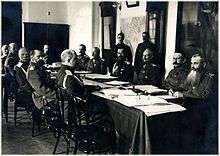
- Nicholas II–Russian Emperor,King of Poland,andGrand Duke of Finland(until 15 March 1917)
- Grand Duke Nicholas Nikolaevich– Commander-in-Chief (1 August 1914 – 5 September 1916) and viceroy in theCaucasus
- Ivan Goremykin–Chairmen of Council of Ministers of the Russian Empire(1 August 1914 – 2 February 1916)
- Boris Stürmer– Chairmen of Council of Ministers of the Russian Empire (2 February 1916 – 23 November 1916)
- Alexander Trepov– Chairmen of Council of Ministers of the Russian Empire (23 November 1916 – 27 December 1916)
- Nikolai Golitsyn– Chairmen of Council of Ministers of the Russian Empire (27 December 1916 – 9 January 1917)
- General of the CavalryAlexander Samsonov– Commander of theRussian Second Armyfor the invasion ofEast Prussia(1 August 1914 – 29 August 1914)
- General of the CavalryPaul von Rennenkampf– Commander of theRussian First Armyfor the invasion of East Prussia (1 August 1914 – November 1914)
- General of the ArtilleryNikolay Ivanov– Commander of the Russian Army on theSouthwestern Front,(1 August 1914 – March 1916) responsible for much of the action inGalicia
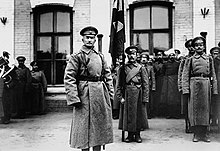
Aleksei Brusilovin Rivne,Volhynian Governorate,1915 - General AdjutantAleksei Brusilov– Commander of the Southwestenr Front, then provisional Commander-in-Chief after the Tsar's abdication (February 1917 – August 1917)
- General of the InfantryLavr Georgievich Kornilov– Commander of the Southwestern Front, then Commander-in-Chief (August 1917)
- General of the InfantryAleksey Kuropatkin– Commander of theNorthern Front(October 1915 – 1917)
- General of the InfantryNikolai Yudenich– Commander of the Caucasus (January 1915 – May 1917)
- AdmiralAndrei Eberhardt– Commander of theBlack Sea Fleet(1914–16)
- AdmiralAlexander Kolchak– Commander of the Black Sea Fleet (1916–17)
- AdmiralNikolai Essen– Commander of theBaltic Fleet(1913 – May 1915)
Belgium
[edit]- Albert I of Belgium–King of the Belgians(23 December 1909 – 17 February 1934) and Commander-in-Chief of the Belgian Army
- Charles de Broqueville–Prime Minister(1912–1918); replaced byGérard Cooremanin June 1918 shortly before the end of the war.
- Félix Wielemans– Chief of Staff of the Belgian Army
- Gérard Leman– general commanding thedefense of Liège
- Charles Tombeur– commander of the colonialForce Publiquein theEast African theatre
France
[edit]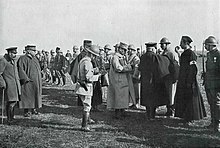
- Raymond Poincaré–President of France
- René Viviani–Prime Minister of France(13 June 1914 – 29 October 1915)
- Aristide Briand– Prime Minister of France (29 October 1915 – 20 March 1917)
- Alexandre Ribot– Prime Minister of France (20 March 1917 – 12 September 1917)
- Paul Painlevé– Prime Minister of France (12 September 1917 – 16 November 1917)
- Georges Clemenceau– Prime Minister of France (from 16 November 1917)
- Divisional General/MarshalJoseph Joffre– Commander-in-Chief of theFrench Army(3 August 1914 – 13 December 1916)
- Divisional GeneralRobert Nivelle– Commander-in-Chief of the French Army (13 December 1916 – April 1917)
- Divisional General/MarshalPhilippe Pétain– Commander-in-Chief of the French Army (April 1917 – 11 November 1918)
- Divisional General/MarshalFerdinand Foch– Supreme Allied Commander (26 March 1918 – 11 November 1918)
- Divisional GeneralMaurice Sarrail– Commander of the Allied armies at theSalonika front(1915–1917)
- Army GeneralAdolphe Guillaumat– Commander of the Allied armies at the Salonika front (1917–1918)
- Divisional General/MarshalLouis Franchet d'Espèrey– Commander of the Allied armies at the Salonika front (1918)
- Brigadier GeneralMilan Rastislav Štefánik– general of the French Army, Commander of the Czechoslovak Legions
Britain and the British Empire
[edit]United Kingdom
[edit]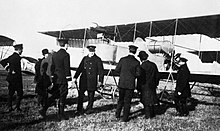

- George V–King of the United Kingdom,and the British Dominions,Emperor of India
- H. H. Asquith–Prime Minister of the United Kingdom(until 5 December 1916)
- David Lloyd George– Prime Minister of the United Kingdom (from 7 December 1916)
- Field MarshalHoratio Herbert Kitchener–Secretary of State for War(5 August 1914 – 5 June 1916)
- Edward Stanley, 17th Earl of Derby– Secretary of State for War (1916– )
- GeneralWilliam Robertson–Chief of the Imperial General Staff(23 December 1915 – February 1918)
- GeneralHenry Wilson– Chief of the Imperial General Staff (February 1918 – February 1922)
- Field MarshalJohn French– Commander-in-Chief of theBritish Expeditionary Force(4 August 1914 – 15 December 1915)
- General/Field MarshalDouglas Haig– Commander-in-Chief of the British Expeditionary Force (15 December 1915 – 11 November 1918)
- GeneralSir David Henderson– Director-General of Military Aeronautics
- GeneralHugh Trenchard– Commander of theRoyal Flying Corps– (August 1915 – January 1918) andChief of the Air Staffof the combinedRoyal Air Force– 1 April 1918 – 13 April 1918
- Brigadier GeneralSirFrederick Sykes–Chief of the Air Staff– 13 April 1918 through 11 November 1918 (post-war to 31 March 1919)
- Winston Churchill–First Lord of the Admiralty– (1911 – May 1915)
- Arthur Balfour- First Lord of the Admiralty – (May 1915 – December 1916)
- Edward Carson– First Lord of the Admiralty – (10 December 1916 – 17 July 1917)
- Eric Geddes– First Lord of the Admiralty – (July 1917 – January 1919)
- Admiral of the FleetJohn "Jackie" Fisher–First Sea Lord– (1914 – May 1915)
- AdmiralHenry Jackson– First Sea Lord – (May 1915 – November 1916)
- AdmiralJohn Jellicoe– Commander of theGrand Fleet(August 1914 – November 1916); First Sea Lord (November 1916 – December 1917)
- AdmiralRosslyn Wemyss– First Sea Lord (December 1917 – November 1919)
- AdmiralDavid Beatty– Commander of the Grand Fleet (November 1916 – April 1919)
- GeneralArchibald Murray– Commander of theEgyptian Expeditionary Force(January 1916 – June 1917)
- GeneralEdmund Allenby– Commander of the Egyptian Expeditionary Force (June 1917 – November 1918)
- Eric John Eagles Swayne– Commander of British forces in theSomaliland Campaign
- William Peyton– commander and military secretary to the British Expeditionary Force
- ColonelT. E. Lawrence– a main leader of theArab Revolt
Dominion of Canada
[edit]- Robert Borden–Prime Minister of Canada(1914–18)
- Sam Hughes–Minister of Militia and Defence(1914 – January 1915)
- Joseph Flavelle– Chairman of theImperial Munitions Board(1915–19)
 Lieutenant-GeneralEdwin Alderson– Commander of the unifiedCanadian Corpsof theCanadian Expeditionary Force(26 January 1915 – September 1915)
Lieutenant-GeneralEdwin Alderson– Commander of the unifiedCanadian Corpsof theCanadian Expeditionary Force(26 January 1915 – September 1915) GeneralJulian Byng– Commander of the unified Canadian Corps of the Canadian Expeditionary Force (June 1916 – June 1917)
GeneralJulian Byng– Commander of the unified Canadian Corps of the Canadian Expeditionary Force (June 1916 – June 1917)- GeneralArthur Currie– Commander of the unified Canadian Corps of the Canadian Expeditionary Force (June 1917 – August 1919)[99]
Commonwealth of Australia
[edit]- Joseph Cook–Prime Minister of Australia(until 17 September 1914)
- Andrew Fisher– Prime Minister of Australia (17 September 1914 – 27 October 1915)
- Billy Hughes– Prime Minister of Australia (from 27 October 1915)
 GeneralWilliam Birdwood– Commander of theAustralian Corps(all five Australian infantry divisions serving on the Western Front) (November 1917 – May 1918)
GeneralWilliam Birdwood– Commander of theAustralian Corps(all five Australian infantry divisions serving on the Western Front) (November 1917 – May 1918)- Lieutenant GeneralSirJohn Monash– Commander of theAustralian Corps(May 1918 –)
- Major GeneralWilliam Holmes– Commander of theAustralian Naval and Military Expeditionary Force(August 1914 – February 1915)
- Lieutenant General SirHarry Chauvel– Commander of theDesert Mounted Corps(Sinai and Palestine) (August 1917 –)
British India
[edit]- Charles Hardinge, 1st Baron Hardinge of Penshurst–Viceroy of India(1910–1916)
- Frederic Thesiger, 1st Viscount Chelmsford– Viceroy of India (1916–1921)
- Robert Crewe-Milnes, 1st Marquess of Crewe–Secretary of State for India(May 1911 – May 1915)
- Austen Chamberlain– Secretary of State for India (May 1915 – July 1917)
- Edwin Samuel Montagu– Secretary of State for India (July 1917 – March 1922)
- Beauchamp Duff–Commander-in-Chief,India (March 1914 – October 1916)
- Charles Monro– Commander-in-Chief, India (October 1916 – November 1920)
- Lieutenant-GeneralJohn Nixon– commander of theBritish Indian Army(active in the Middle East)
Union of South Africa
[edit]- GeneralLouis Botha–Prime Minister of South Africa
- GeneralJan Smuts– led forces in theSouth West Africa CampaignandEast African Campaign,later a member of theImperial War Cabinet
Dominion of New Zealand
[edit]- William Massey–Prime Minister of New Zealand
- General SirAlexander Godley– Commandant of New Zealand Military Forces (to October 1914); Commander of theNew Zealand Expeditionary Forces
- Major General SirAlfred William Robin– Quartermaster-General and Commandant of New Zealand Military Forces (from October 1914)
- Major General SirAndrew Hamilton Russell– Commander of theNew Zealand Division
Dominion of Newfoundland
[edit]- Sir Edward Morris–Prime Minister of Newfoundland(1909–1917)
- Sir John Crosbie– Prime Minister of Newfoundland (1917–1918)
- Sir William Lloyd– Prime Minister of Newfoundland (1918–1919)
Japan
[edit]- Emperor Taishō–Emperor of Japan
- Ōkuma Shigenobu–Prime Minister of Japan(16 April 1914 – 9 October 1916)
- Terauchi Masatake– Prime Minister of Japan (9 October 1916 – 29 September 1918)
- Hara Takashi– Prime Minister of Japan (29 September 1918 – 4 November 1921)
- Katō Sadakichi– Commander-in-Chief of theSecond Fleetdeployed to theSiege of Tsingtao
- Kōzō Satō– Commander of the Second Special Task Fleet
- Kamio Mitsuomi– Commander of Allied land forcesat Tsingtao
Italy (1915–1918)
[edit]- Victor Emmanuel III–King of Italy
- Antonio Salandra–Prime Minister(until 18 June 1916)
- Paolo Boselli– Prime Minister (18 June 1916 – 29 October 1917)
- Vittorio Emanuele Orlando– Prime Minister (from 29 October 1917)
- Luigi Cadorna– Commander-in-Chief of theRoyal Italian Army
- Armando Diaz– Chief of General Staff of the Royal Italian Army
- Luigi, Duke of Abruzzi– Commander-in-Chief of the Adriatic Fleet of Italy (1914–17)
- Paolo Thaon di Revel– Admiral of theRoyal Italian Navy
Romania (1916–1918)
[edit]- Ferdinand I–King of Romania
- GeneralConstantin Prezan– Chief of the General Staff of Romania
- Ion I. C. Brătianu– Prime Minister of Romania
- Vintilă Brătianu– Secretary of War
- Field MarshalAlexandru Averescu– Commander of the2nd Army,3rd Army, then Army Group South
- GeneralEremia Grigorescu– Commander of the1st Army
Portugal (1916–1918)
[edit]- Bernardino Machado–President of Portugal(until 12 December 1917)
- Afonso Costa–Prime Minister of Portugal(until 15 March 1916; then again 25 April 1917 – 10 December 1917)
- António José de Almeida– Prime Minister of Portugal (15 March 1916 – 25 April 1917)
- Sidónio Pais– Prime Minister of Portugal and War Minister (11 December 1917 – 9 May 1918) and President of Portugal (from 9 May 1918)
- José Norton de Matos– War Minister (until 10 December 1917)
- João Tamagnini Barbosa– Interim War Minister (9 May 1918 – 15 May 1918)
- Amílcar Mota – Secretary of State for War (15 May 1918 – 8 October 1918)
- Álvaro de Mendonça – Secretary of State for War (from 8 October 1918)
- Fernando Tamagnini de Abreu– Commander of thePortuguese Expeditionary Corps (CEP)
- José Augusto Alves Roçadas– Commander of the Portuguese Forces in Southern Angola
- José Luís de Moura Mendes – Commander of the Portuguese Forces in Eastern Africa (until June 1916)
- José César Ferreira Gil– Commander of the Portuguese Forces in Eastern Africa (from June 1916)
- Sousa Rosa – Commander of the Portuguese Forces in Eastern Africa (from 1917)
Greece (1916/17–1918)
[edit]
- Constantine I:King of Greece, he retired from the throne in June 1917, due to Allied pressure, without formally abdicating.
- Alexander:King of Greece from 1917 after his father was forced into exile
- Eleftherios Venizelos:Prime Minister of Greece after 13 June 1917
- Panagiotis Danglis:Greek general of the Hellenic Army
United States (1916–1918)
[edit]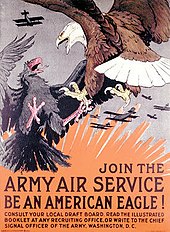
- Woodrow Wilson–President of the United States/Commander-In-Chief of the US Armed Forces
- Newton D. Baker–US Secretary of War
- Josephus Daniels–US Secretary of the Navy
- Major General/GeneralJohn J. Pershing– Commander of theAmerican Expeditionary Forces
- Rear Admiral/Vice AdmiralWilliam Sims– Commander ofUS Naval Forces in European Waters
- Brigadier GeneralMason Patrick– Commander of theUS Army Air Service
Siam (Thailand) (1917–1918)
[edit]
- Rama VI–King of Siam
- Field MarshalChao Phraya Bodindechanuchit–Minister of Defence
- Prince Chakrabongse Bhuvanath– Supreme Commander of the Siamese Expeditionary Forces inWorld War I
- GeneralPhraya Bijai Janriddhi– Commander of theSiamese Expeditionary Forcesin theWestern Front
Brazil (1917–1918)
[edit]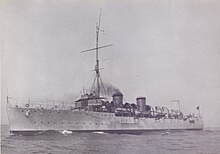
- Venceslau Brás–President of Brazil
- Pedro Frontin,Chief of theDivisão Naval em Operações de Guerra(Naval Division in War Operations)
- José Pessoa Cavalcanti de Albuquerque,lieutenant of the Brazilian Army in France
- Napoleão Felipe Aché, Chief of Brazilian Military Mission in France (1918–1919)
- M.D.Nabuco Gouveia – Chief of Brazilian Military Medical Commission
Armenia (1917–1918)
[edit]- Hovhannes Kajaznuni– firstPrime Ministerof theFirst Republic of Armenia
- General Andranik– military commander and statesman of theCaucasus Campaign
- Aram Manukian– Minister of Internal Affairs of the First Republic of Armenia
- Drastamat Kanayan– military commander and member of theArmenian Revolutionary Federation
- Tovmas Nazarbekian– Commander-in-Chief of the First Republic of Armenia
- Movses Silikyan– army general and national hero
Czechoslovakia (1918)
[edit]- Tomáš Garrigue Masaryk– firstPresidentofCzechoslovakia
- Milan Rastislav Štefánik– Commander of theCzechoslovak Legion
- Edvard Beneš–Minister of Foreign Affairsandthe Interior
Personnel and casualties
[edit]
These are estimates of the cumulative number of different personnel in uniform 1914–1918, including army, navy and auxiliary forces. At any one time, the various forces were much smaller. Only a fraction of them were frontline combat troops. The numbers do not reflect the length of time each country was involved.
| Allied power | Mobilized personnel | Military fatalities | Wounded in action | Casualties, total | Casualties, % of total mobilised |
|---|---|---|---|---|---|
| Australia | 412,953[13] | 61,928 (14.99%)[f] | 152,171 | 214,099 | 52% |
| Belgium | 267,000[11] | 38,172 (14.29%)[g] | 44,686 | 82,858 | 31% |
| Brazil | 1,713[105][page needed] | 100 (5.84%)[106] | 0 | 100 | 5.84% |
| Canada | 628,964[13] | 64,944 (10.32%)[h] | 149,732 | 214,676 | 34% |
| France | 8,410,000[11] | 1,397,800 (16.62%)[i] | 4,266,000 | 5,663,800 | 67% |
| Greece | 230,000[11] | 26,000 (11.30%)[j] | 21,000 | 47,000 | 20% |
| India | 1,440,437[13] | 74,187 (5.15%)[k] | 69,214 | 143,401 | 10% |
| Italy | 5,615,000[11] | 651,010 (11.59%)[l] | 953,886 | 1,604,896 | 29% |
| Japan | 800,000[11] | 415 (0.05%)[m] | 907 | 1,322 | <1% |
| Monaco | 80[112] | 8 (10.00%)[112] | 0 | 8[112] | 10% |
| Montenegro | 50,000[11] | 3,000 (6.00%) | 10,000 | 13,000 | 26% |
| Nepal | 200,000[113] | 30,670 (15.33%) | 21,009 | 49,823 | 25% |
| New Zealand | 128,525[13] | 18,050 (14.04%)[n] | 41,317 | 59,367 | 46% |
| Portugal | 100,000[11] | 7,222 (7.22%)[o] | 13,751 | 20,973 | 21% |
| Romania | 750,000[11] | 250,000 (33.33%)[p] | 120,000 | 370,000 | 49% |
| Russia | 12,000,000[11] | 1,811,000 (15.09%)[q] | 4,950,000 | 6,761,000 | 56% |
| Serbia | 707,343[11] | 275,000 (38.87%)[r] | 133,148 | 408,148 | 58% |
| Siam | 1,284[12][page needed] | 19 (1.48%) | 0 | 19 | 2% |
| South Africa | 136,070[13] | 9,463 (6.95%)[s] | 12,029 | 21,492 | 16% |
| United Kingdom | 6,211,922[12] | 886,342 (14.26%)[t] | 1,665,749 | 2,552,091 | 41% |
| United States | 4,355,000[11] | 53,402 (1.23%)[u] | 205,690 | 259,092 | 5.9% |
| Total | 42,244,409 | 5,741,389 | 12,925,833 | 18,744,547 | 49% |
See also
[edit]- Allied intervention in the Russian Civil War
- Causes of World War I
- Color books,transcripts of official documents released by each nation early in the war
- Diplomatic history of World War I
- Historiography of the causes of World War I
- Home front during World War I
- International relations of the Great Powers (1814–1919)
- July Crisis
Footnotes
[edit]- ^From April 1915
- ^After the abdication ofEmperorNicholas IIin theFebruary Revolutionof 1917, the newprovisional Governmentkept Russia in the war, forming aRussian Republicin September. TheOctober Revolutionthe same year led to theBolshevikseizure of power. The new regime renamed the country theRussian Soviet Republicand oversaw the signing of theseparate peaceTreaty of Brest-Litovskwith large concessions in March 1918. The country then quickly degenerated into theRussian Civil War.
- ^From 6 April 1917, as an Associated Power
- ^The consequences were demonstrated when Germany controlled these areas during 1940–1944.
- ^Others includedGibraltar,Cyprus,Malta,East Africa Protectorate,Nyasaland,NorthernandSouthern Rhodesia,theUganda Protectorate,theGold Coast,Nigeria,British Honduras,theFalkland Islands,British Guiana,theBritish West Indies,British Malaya,North Borneo,CeylonandHong Kong.
- ^Australia casualties
Included in total are 55,000 killed or missing in action and died of wounds[100]-.
TheCommonwealth War Graves CommissionAnnual Report 2005–2006 is the source of total military dead.[101]–
Totals include 2,005 military deaths during 1919–21[102]–. The 1922War Officereport listed 59,330 Army war dead.[103] - ^Belgium casualties
Included in total are 35,000 killed or missing in action and died of wounds[100]Figures include 13,716 killed and 24,456 missing up until Nov.11, 1918. "These figures are approximate only, the records being incomplete.".[104] - ^Canada casualties
Included in total are 53,000 killed or missing in action and died of wounds.[100]
TheCommonwealth War Graves CommissionAnnual Report 2005–2006 is the source of total military dead.[101]
Totals include 3,789 military deaths during 1919–21 and 150Merchant Navydeaths[102]–. The losses of Newfoundland are listed separately on this table. The 1922War Officereport listed 56,639 Army war dead.[103] - ^France casualties
Included in total are 1,186,000 killed or missing in action and died of wounds.[100]Totals include the deaths of 71,100 French colonial troops.[107]-Figures include war related military deaths of 28,600 from 11/11/1918 to 6/1/1919.[107] - ^Greece casualties
Jean Bujac in a campaign history of the Greek Army in World War One listed 8,365 combat related deaths and 3,255 missing,[108]The Soviet researcher Boris Urlanis estimated total dead of 26,000 including 15,000 military deaths due disease[109] - ^India casualties
British India included present-day India,PakistanandBangladesh.
Included in total are 27,000 killed or missing in action and died of wounds.[100]
TheCommonwealth War Graves CommissionAnnual Report 2005–2006 is the source of total military dead.[101]
Totals include 15,069 military deaths during 1919–21 and 1,841Canadian Merchant Navydead.[102]The 1922War Officereport listed 64,454 Army war dead[103] - ^Italy casualties
Included in total are 433,000 killed or missing in action and died of wounds[100]
Figures of total military dead are from a 1925 Italian report using official data.[110][page needed] - ^War dead figure is from a 1991 history of the Japanese Army.[111]
- ^New Zealand casualties
Included in total are 14,000 killed or missing in action and died of wounds.[100]
TheCommonwealth War Graves CommissionAnnual Report 2005–2006 is the source of total military dead.[101]
Totals include 702 military deaths during 1919–21.[102]The 1922War Officereport listed 16,711 Army war dead.[103] - ^Portugal casualties
Figures include the following killed and died of other causes up until Jan.1, 1920; 1,689 in France and 5,332 in Africa. Figures do not include an additional 12,318 listed as missing andPOW.[114] - ^Romania casualties
Military dead is "The figure reported by the Rumanian Government in reply to a questionnaire from the International Labour Office".[115]Included in total are 177,000 killed or missing in action and died of wounds.[100] - ^Russia casualties
Included in total are 1,451,000 killed or missing in action and died of wounds.[100]The estimate of total Russian military losses was made by the Soviet researcher Boris Urlanis.[116] - ^Serbia casualties
Included in total are 165,000 killed or missing in action and died of wounds.[100]The estimate of total combined Serbian and Montenegrin military losses of 278,000 was made by the Soviet researcher Boris Urlanis[117] - ^South Africa casualties
Included in total are 5,000 killed or missing in action and died of wounds[100]
TheCommonwealth War Graves CommissionAnnual Report 2005–2006 is the source of total military dead.[101]
Totals include 380 military deaths during 1919–2115.The 1922War Officereport listed 7,121 Army war dead.[103] - ^UK andCrown Coloniescasualties
Included in total are 624,000 killed or missing in action and died of wounds.[100]
TheCommonwealth War Graves CommissionAnnual Report 2005–2006 is the source of total military dead.[101]
Military dead total includes 34,663 deaths during 1919–21 and 13,632British Merchant Navydeaths.[102]The 1922War Officereport listed 702,410 war dead for the UK,[103]507 from "Other colonies"[103]and theRoyal Navy(32,287).[118]
TheBritish Merchant Navylosses of 14,661 were listed separately;[118]The 1922War Officereport detailed the deaths of 310 military personnel due to air and sea bombardment of the UK.[119] - ^United States casualties
Official military war deaths listed by the US Dept. of Defense for the period ending 31 Dec 1918 are 116,516; which includes 53,402 battle deaths and 63,114 other deaths."Principal Wars in Which the United States Participated U.S. Military Personnel Serving and Casualties a/"(PDF).Department of Defense Statistical Information Analysis Division. Archived fromthe original(PDF)on 25 January 2007.The US Coast Guard lost an additional 192 dead.[120]
References
[edit]- ^Torkunov, Anatoly V.; Martyn, Boris F.; Wohlforth, William C. (8 January 2020).History of International Relations and Russian Foreign Policy in the 20th Century (Volume I).Cambridge Scholars.ISBN9781527545021.
- ^Torkunov, Anatoly V.; Wohlforth, William C.; Martyn, Boris F. (8 January 2020).History of International Relations and Russian Foreign Policy in the 20th Century (Volume I).Cambridge Scholars.ISBN978-1-5275-4502-1.
- ^Karel Schelle,The First World War and the Paris Peace Agreement,GRIN Verlag, 2009,p. 24
- ^Preamble,Treaty of VersaillesAustralian Treaty Series 1920 No 1
- ^Gilbert 1995,p. 44.
- ^Mizokami, Kyle, "Japan's baptism of fire: World War I put country on a collision course with WestArchived31 July 2018 at theWayback Machine",The Japan Times,27 July 2014
- ^Gilbert 1995,p. 225.
- ^abGilbert 1995,p. 282.
- ^Magliveras, Konstantin (1999).Exclusion from Participation in International Organisations: The Law and Practice Behind Member States' Expulsion and Suspension of Membership.Brill. pp. 8–12.ISBN978-90-411-1239-2.
- ^S.N. Broadberry; Mark Harrison (2005).The Economics of World War I. illustrated.Cambridge University Press. p. 7.ISBN978-1-139-44835-2.Retrieved16 March2015.
- ^abcdefghijklmnopqrstTucker, Spencer C (1999).The European Powers in the First World War: An Encyclopedia.New York: Garland. p. 172.ISBN978-0-8153-3351-7.
- ^abcdGilbert, Martin (1994).Atlas of World War I.Oxford University Press.ISBN978-0-19-521077-4.OCLC233987354.
- ^abcdefgWar Office Statistics 2006,p. 756.
- ^Indian Armyonly
- ^Baker, Chris."Some British Army statistics of the Great War".1914-1918.net.Archived fromthe originalon 18 July 2017.Retrieved7 August2017.
- ^Korea,Formosa,KwantungandSakhalin
- ^AsHawaiiandAlaskawere not yetU.S. states,they are included in the dependencies.
- ^Costa Rica, Cuba, Guatemala, Haiti, Honduras, Nicaragua and Panama
- ^Hernâni Donato (1987).Dicionário das Batalhas Brasileiras.Rio de Janeiro: IBRASA.ISBN978-85-348-0034-1.
- ^S.N. Broadberry; Mark Harrison (2005).The Economics of World War I. illustrated.Cambridge University Press. p. 8.ISBN978-1-139-44835-2.Retrieved16 March2015.
- ^Germany (and colonies), Austria-Hungary, Ottoman Empire and Bulgaria
- ^Avner Cohen, "Joseph Chamberlain, Lord Lansdowne and British foreign policy 1901–1903: From collaboration to confrontation."Australian Journal of Politics & History43#2 (1997): 122–134.
- ^Massie, Robert (2007).Dreadnought: Britain, Germany and the Coming of the Great War(2013 ed.). Vintage. pp. 466–468.ISBN978-0-09-952402-1.
- ^Nilesh, Preeta (2014). "Belgian Neutrality and the First world War; Some Insights".Proceedings of the Indian History Congress.75:1014.JSTOR44158486.
- ^Hull, Isabel (2014).A Scrap of Paper: Breaking and Making International Law during the Great War.Cornell University Press. p. 17.ISBN978-0-8014-5273-4.
- ^Schreuder, Deryck (Spring 1978). "Gladstone as" Troublemaker ": Liberal Foreign Policy and the German Annexation of Alsace-Lorraine, 1870–1871".Journal of British Studies.17(2): 108–109.doi:10.1086/385724.JSTOR175393.S2CID145137541.
- ^Jenkins, Roy (1964).Asquith(1988 Revised and Updated ed.). Harpers Collins. pp. 242–245.ISBN978-0-00-217358-2.
- ^Catriona Pennell (2012).A Kingdom United: Popular Responses to the Outbreak of the First World War in Britain and Ireland.OUP Oxford. p. 27.ISBN978-0-19-959058-2.
- ^Cassar, George (1994).Asquith as War Leader.Bloomsbury. pp. 14–17.ISBN978-1-85285-117-0.
- ^abBrock, Michael; Brock, Elinor, eds. (2014).Margot Asquith's Great War Diary 1914–1916: The View from Downing Street(Kindle ed.). OUP Oxford; Reprint edition. pp. 852–864.ISBN978-0-19-873772-8.
- ^Gullace, Nicoletta F (June 1997). "Sexual Violence and Family Honor: British Propaganda and International Law during the First World War".The American Historical Review.102(3): 717.doi:10.2307/2171507.JSTOR2171507.
- ^Tucker, Spencer C. A Global Chronology of Conflict: From the Ancient World to the Modern Middle East: From the Ancient World to the Modern Middle East. ABC-CLIO. 2009. P1562.
- ^Stephen J. Lee (2005).Aspects of British Political History 1914–1995.Routledge. pp. 21–22.ISBN978-1-134-79040-1.
- ^Schuyler, Robert Livingston (March 1920). "The British Cabinet, 1916–1919".Political Science Quarterly.35(1): 77–93.doi:10.2307/2141500.JSTOR2141500.
- ^Perry (2004), p.xiii
- ^Hopkirk, Peter (1990).The Great Game; On Secret Service in High Asia(1991 ed.). OUP. pp. 4–5.ISBN978-0-7195-6447-5.
- ^abDennis, Alfred L.P. (December 1922). "The Freedom of the Straits".The North American Review.216(805): 728–729.JSTOR25112888.
- ^abStowell, Ellery Cory (1915).The Diplomacy of the War of 1914: The Beginnings of the War(2010 ed.). Kessinger Publishing. p. 94.ISBN978-1-165-81956-0.
- ^Jelavich, Barbara (2008).Russia's Balkan Entanglements.Cambridge University Press. p. 262.ISBN978-0-521-52250-2.
- ^Aksakal, Mustafa (2012). "War as a Saviour? Hopes for War & Peace in Ottoman Politics before 1914". In Afflerbach, Holger; Stevenson, David (eds.).An Improbable War? the Outbreak of World War I and European Political Culture Before 1914.Berghahn Books. p. 293.ISBN978-0-85745-310-5.
- ^Baux, Jean-Pierre."1914; A Demographically Weakened France".Chemins de Memoire.Archivedfrom the original on 19 August 2018.Retrieved18 August2018.
- ^Starns, Karl M (2012).The Russian Railways and Imperial Intersections in the Russian Empire(PDF).Master of Arts in International Studies Thesis for Washington University. pp. 47–49.Archived(PDF)from the original on 26 March 2017.Retrieved19 August2018.
- ^abBrock, Michael; Brock, Elinor, eds. (2014).Margot Asquith's Great War Diary 1914–1916: The View from Downing Street(Kindle ed.). OUP Oxford; Reprint edition. pp. 759–781.ISBN978-0-19-873772-8.
- ^Tucker, Spencer C.A Global Chronology of Conflict: From the Ancient World to the Modern Middle East: From the Ancient World to the Modern Middle East.ABC-CLIO. 2009. p. 1556.
- ^Hargreaves, John (1983). "French West Africa in the First World War; a review of L'Appel à l'Afrique. Contributions et Réactions à l'Effort de guerre en A.O.F. (1914–1919) by Marc Michel".The Journal of African History.24(2): 285–288.doi:10.1017/S002185370002199X.JSTOR181646.S2CID161424205.
- ^Koller, Christian."Colonial Military Participation in Europe".1914–1918 Online.Archivedfrom the original on 19 August 2018.Retrieved19 August2018.
- ^Tanenbaum, Jan Karl (1978). "France and the Arab Middle East, 1914–1920".Transactions of the American Philosophical Society.68(7): 5.doi:10.2307/1006273.JSTOR1006273.
- ^Cavendish, Richard (January 2002)."The 1902 Anglo-Japanese Alliance".History Today.52(1).Archivedfrom the original on 16 August 2018.Retrieved15 August2018.
- ^Gilbert 1995,p. 123.
- ^"Tuyên chiến の chiếu thư [Sensen no shōsho, Imperial Rescript on Declaration of War] (Aug. 23, 1914), Kanpō, Extra ed"(PDF).Library of Congress.Archived(PDF)from the original on 1 September 2017.
- ^Gilbert 1995,p. 329.
- ^Zhitian Luo, "National humiliation and national assertion-The Chinese response to the twenty-one demands",Modern Asian Studies(1993) 27#2 pp 297–319.
- ^Gilbert 1995,p. 522.
- ^Thompson, Mark (2008).The White War.Faber. pp. 13–14.ISBN978-0-571-22334-3.
- ^Thompson, Mark (2008).The White War.Faber. p. 22.ISBN978-0-571-22334-3.
- ^abHamilton, Richard F; Herwig, Holger H.Decisions for War, 1914–1917.p. 194.
- ^Clark, Mark (2008).Modern Italy, 1871 to the Present (Longman History of Italy).Routledge. p. 219.ISBN978-1-4058-2352-4.
- ^Thompson, Mark (2008).The White War.Faber. p. 23.ISBN978-0-571-22334-3.
- ^Hamilton, Richard F; Herwig, Holger H.Decisions for War, 1914–1917.pp. 194–198.
- ^Thompson, Mark (2008).The White War.Faber. pp. 378–382.ISBN978-0-571-22334-3.
- ^Roudometof, Victor (2001).Nationalism, Globalization, and Orthodoxy: The Social Origins of Ethnic Conflict in the Balkans.Praeger Publishing. p. 79.ISBN978-0-313-31949-5.
- ^Clark, Christopher (2013).The Sleepwalkers.Harper. pp.282–283.ISBN978-0-06-114665-7.
- ^Clark, Christopher (2013).The Sleepwalkers.Harper. p.285.ISBN978-0-06-114665-7.
- ^Hull, Isabel V (2014).A Scrap of Paper: Breaking and Making International Law during the Great War.Cornell University. pp. Chapter 2 Belgian Neutrality.ISBN978-0-8014-5273-4.
- ^van Reybrouck, David (2014).Congo: The Epic History of a People.Harper Collins. pp. 132 passim.ISBN978-0-06-220012-9.
- ^Strachan, Hew (2014).First World War; a New History.Simon & Schuster UK. p. 70.ISBN978-1-4711-3426-5.
- ^Mazower, Mark (December 1992). "The Messiah and the Bourgeoisie: Venizelos and Politics in Greece, 1909 – 1912".The Historical Journal.35(4): 886.doi:10.1017/S0018246X00026200.JSTOR2639443.S2CID154495315.
- ^abMitchell, Dennis J (1996). Tucker, Spencer C (ed.).The European Powers in the First World War: An Encyclopedia.Routledge. pp. 195–196.ISBN978-0-8153-0399-2.Archivedfrom the original on 3 September 2018.Retrieved2 September2018.
- ^Kaldis, William Peter (June 1979). "Background for Conflict: Greece, Turkey, and the Aegean Islands, 1912–1914".The Journal of Modern History.51(2): D1119–D1146.doi:10.1086/242039.JSTOR1881125.S2CID144142861.
- ^Treadway, John (1983).The Falcon and the Eagle: Montenegro and Austria-Hungary, 1908–14.Purdue Press. pp. 150–153.ISBN978-0-911198-65-2.
- ^Elsie, Robert(2010).Historical Dictionary of Albania.Historical Dictionaries of Europe. Vol. 75 (2 ed.). Scarecrow Press. p. 255.ISBN978-0810861886.
- ^abRaspopović, Radoslav."Montenegro".encyclopedia.1914-1918-online.Archivedfrom the original on 6 September 2018.Retrieved5 September2018.
- ^Treadway, John (1983).The Falcon and the Eagle: Montenegro and Austria-Hungary, 1908–14.Purdue Press. pp. 186–189.ISBN978-0-911198-65-2.
- ^Mehra, Ram Narain (1988).Aden & Yemen, 1905–1919.Agam Prakashan. pp. 125, 159.
- ^Records of Yemen, 1797–1960: 1950–1954.Archive Editions. 1993. p. 397.ISBN978-1852073701.
- ^Abdullah I of Jordan;Philip Perceval Graves(1950).Memoirs.p. 186.
- ^Clark, Charles Upson (1971).United Roumania.Arno Press. p. 135.ISBN978-0405027413.
- ^Spencer C. Tucker, Priscilla Mary Roberts,Encyclopedia of World War I,p. 273
- ^Adrian Storea, Gheorghe Băjenaru,Artileria română în date și imagini (Romanian artillery in data and pictures),pp. 40, 49, 50, 54, 59, 61, 63, 65, and 66 (in Romanian)
- ^Jozef Wilczynski,Technology in Comecon: Acceleration of Technological Progress Through Economic Planning and the Market,p. 243
- ^International Naval Research Organization,Warship International, Volume 21,p. 160
- ^Frederick Thomas Jane,Jane's Fighting Ships,p. 343[full citation needed]
- ^Robert Gardiner,Conway's All the World Fighting Ships 1906–1921,p. 422
- ^Adrian Storea, Gheorghe Băjenaru,Artileria română în date și imagini (Romanian artillery in data and pictures),p. 53 (in Romanian)
- ^Torrey, Glenn E. (1998).Romania and World War I.Center for Romanian Studies. p. 58.ISBN978-9739839167.
- ^Michael Hundertmark, Holger Steinle,Phoenix aus der Asche – Die Deutsche Luftfahrt Sammlung Berlin,pp. 110–114 (in German)
- ^România în anii primului război mondial (Romania in the years of the First World War), Volume II,p. 830 (in Romanian)
- ^Gilbert 1995,p. 287.
- ^King of Battle: Artillery in World War I.Brill. 2016. p. 347.ISBN978-9004307285.
- ^Konstam, Angus (2015).Gunboats of World War I.Bloomsbury Publishing. p. 29.ISBN978-1472804990.
- ^Greger, René (1976).Austro-Hungarian warships of World War I.Allan. p. 142.ISBN978-0711006232.
- ^"First World War.com – Primary Documents – U.S. Declaration of War with Germany, 2 April 1917".Archivedfrom the original on 16 May 2008.Retrieved12 May2008.
- ^Tucker&Roberts pp. 1232, 1264, 1559
- ^Tucker&Roberts p. 1559
- ^Malek, Yusuf (1935).The British Betrayal of the Assyrians.Assyrian International News Agency.
- ^Paul Bartrop, Encountering Genocide: Personal Accounts from Victims, Perpetrators, and Witnesses, ABC-CLIO, 2014
- ^Naayem, Joseph (30 July 1921)."Shall this Nation Die?".Chaldean rescue – via Google Books.
- ^Eskander, Saad."Britain's Policy Towards The Kurdish Question, 1915–1923"(PDF).etheses.lse.ac.uk.p. 45.
- ^first Canadian to attain the rank of fullgeneral
- ^abcdefghijklUrlanis 2003,p. 85.
- ^abcdefCWGC 2006.
- ^abcdeCWGC 2012.
- ^abcdefgWar Office Statistics 2006,p. 237.
- ^War Office Statistics 2006,p. 352.
- ^Donato 1987.
- ^Francisco Verras; "D.N.O.G.: contribuicao da Marinha Brasileira na Grande Guerra" ( "DNOG; the role of Brazilian Navy in the Great War" )(in Portuguese)"A Noite" Ed. 1920
- ^abHuber 1931,p. 414.
- ^Bujac 1930,p. 339.
- ^Urlanis 2003,p. 160.
- ^Mortara 1925.
- ^Harries & Harries 1991,p. 111.
- ^abc"Monaco 11-Novembre: ces Monégasques morts au champ d'honneur".Archivedfrom the original on 2 April 2015.Retrieved31 December2012.
- ^Jain, G (1954) India Meets China in Nepal, Asia Publishing House, Bombay P92
- ^War Office Statistics 2006,p. 354.
- ^Urlanis 2003,p. 64.
- ^Urlanis 2003,p. 46–57.
- ^Urlanis 2003,p. 62–64.
- ^abWar Office Statistics 2006,p. 339.
- ^War Office Statistics 2006,p. 674–678.
- ^Clodfelter 2002,p. 481.
Bibliography
[edit]- Ellis, John and Mike Cox.The World War I Databook: The Essential Facts and Figures for All the Combatants(2002)
- Esposito, Vincent J.The West Point Atlas of American Wars: 1900–1918(1997); despite the title covers entire war;online maps from this atlas
- Falls, Cyril.The Great War(1960), general military history
- Gilbert, Martin (1995).First World War.HarperCollins.ISBN978-0006376668.OCLC1244719073.
- Gooch, G. P.Recent Revelations of European Diplomacy(1940), 475pp; summarises memoirs of major participants
- Higham, Robin and Dennis E. Showalter, eds.Researching World War I: A Handbook(2003); historiography, stressing military themes
- Pope, Stephen and Wheal, Elizabeth-Anne, eds.The Macmillan Dictionary of the First World War(1995)
- Strachan, Hew.The First World War: Volume I: To Arms(2004)
- Trask, David F.The United States in the Supreme War Council: American War Aims and Inter-Allied Strategy, 1917–1918(1961)
- Tucker Spencer C (1999).The European Powers in the First World War: An Encyclopedia.New York: Garland.ISBN978-0-8153-3351-7.
- Tucker, Spencer, ed.The Encyclopedia of World War I: A Political, Social, and Military History(5 volumes) (2005); online at eBook.com
- United States. War Dept. General Staff.Strength and organisation of the armies of France, Germany, Austria, Russia, England, Italy, Mexico and Japan (showing conditions in July, 1914)(1916)online
- The War Office (2006) [1922].Statistics of the Military Effort of the British Empire During the Great War 1914–1920.Uckfield, East Sussex: Military and Naval Press.ISBN978-1-84734-681-0.OCLC137236769.
- CWGC(2006),Annual Report 2005–2006(PDF),archived fromthe original(PDF)on 16 June 2007,retrieved28 January2007
- CWGC(2012),Debt of Honour Register,archived fromthe originalon 18 January 2012
- Urlanis, Boris (2003) [1971, Moscow].Wars and Population.Honolulu: University Press of the Pacific.OCLC123124938.
- Huber, Michel (1931).La population de la France pendant la guerre, avec un appendice sur Les revenus avant et après la guerre(in French). Paris.OCLC4226464.
{{cite book}}:CS1 maint: location missing publisher (link) - Bujac, Jean Léopold Emile (1930).Les campagnes de l'armèe Hellènique 1918–1922(in French). Paris: Charles-Lavauzelle.OCLC10808602.
- Mortara, Giorgio (1925).La Salute pubblica in Italia durante e dopo la Guerra(in Italian). New Haven, Connecticut: Yale University Press.OCLC2099099.
- Harries, Merion; Harries, Susie (1991).Soldiers of the Sun: The Rise and Fall of the Imperial Japanese Army.Random House.ISBN978-0-679-75303-2.OCLC32615324.
- Clodfelter, Micheal (2002).Warfare and Armed Conflicts: A Statistical Reference to Casualty and Other Figures, 1500–2000(2nd ed.). London: McFarland.ISBN978-0-7864-1204-4.OCLC48066096.
- Donato, Hernâni (1987).Dicionário das Batalhas Brasileiras.Rio de Janeiro: IBRASA.ISBN978-85-348-0034-1.
- Allies of World War I
- 1919 in law
- 20th-century military alliances
- Aftermath of World War I
- Military alliances involving Australia
- Military alliances involving Canada
- Military alliances involving France
- Military alliances involving New Zealand
- Military alliances involving South Africa
- Military alliances involving the United Kingdom
- Military alliances involving the United States
- World War I by country
- History of diplomacy
